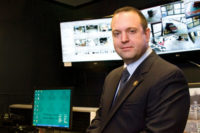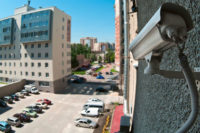Trail Mix: Five Good Ways to Track People










Melissa Maddox has a lot of visitors, a lot of very important visitors, who stop in to view their very expensive assets in a very expansive facility.
Visitors used to be physically escorted at all times by staff members, a cumbersome, time and expense consuming process that proved uncomfortable for some of those visitors.
Maddox’s solution: virtual escorts using a combination of security technologies, less staff involvement and visitor thumbs-up feedback.
Jeff Hayes has a lot of VIPs to track and locate, too, with his “I” mostly meaning inmates.
He uses a very integrated approach: Touchscreens control doors within his facility and are connected to adjacent monitors showing myriad camera views while relevant video automatically displays whenever an intercom call is placed via security devices. About 550 inmates are constantly tracked as well as, for their personal safety, 135 or so correctional staff.
People tracking, overcoming its sometimes Peeping Tom, Big Brother image, boasts both long existing and on-horizon applications that have business benefits, increasing the level of security while also, many times, saving lives.
There are diverse technologies among the mix to trail and locate people. While some are specific to one type of business or another, most can apply to numerous kinds of enterprises. Or can act as a template for others with a simple twist or turn.
What follows are five top people tracking solutions. Some are grounded in specific organizational use while others are tools that can be applied in many ways.
One– Virtual Escorts
Melissa Maddox has managed to create a neat solution.
Blending security technology with a need to more appropriately host customers at her facility, she created a welcoming process that electronically but unintrusively escorts distinguished visitors at StandardAero’s Augusta Regional Airport facility in Augusta, Ga. while, at the same time, cutting the time, expense and at times difficulty of physically escorting a visitor.
This “virtual escort” program is a high-flying solution that seems to have taken off quite well.
Founded way back in 1911, StandardAero is one of the largest independent maintenance, repair and overhaul (MRO) aviation service businesses in the world, providing comprehensive services to commercial, military, business aviation, helicopters and industrial operators.
“The technology was brought in exclusively for our business customers, aviation directors of maintenance, pilots, representatives and owners who are working on site during the maintenance process. In the past, these visitors were physically escorted when at the facility. We carefully listened to our customers,” said Maddox, vice president of legal risk management for StandardAero, commenting on that part of the experience. She evaluated the challenge and found a unique way to track visitors via radio frequency identification tags on identification badges issued by StandardAero instead of physically escorting them.
Maddox set three goals in picking a solution:
• “Be equal to the preventive qualities of physical escorting, that is facilitate monitoring and validation at all times.
• “Be invisible in design to the customer. We don’t keep it a secret; we actually provide a brochure explaining what e-Escort is and ask for their feedback on it.
• “Be operationally easy on the business. If it’s not seamless, it won’t work – period.”
“Overall, it keeps our employees focused on their primary duties,” says Maddox. “It reduces the need for people who escort; it increases the level of security in a less visible way; and eEscort works with an existing Pro-Watch security management system from Honeywell Integrated Security.” In the past, “when an owner or operator left the operations area, they would have to wait for an escort before reentering the area where their aircraft was,” says Maddox. “It was very cumbersome and unproductive for the facility as well as the customer.”
Now, customers are issued a package that includes a photo ID badge with a RFID tag integrated with cameras. The badges grant access to all authorized areas to permit visitors to move freely. “I have a security operations room where a set of eight monitors and one officer monitor the assets in the area where visitors are located. Since we wanted the officer to focus exclusively on the areas where visitors were located, only areas active zones are shown on the screen. The monitors are otherwise blank,” adds Maddox.
“Only those zones activated by the tag are monitored, so the security staff attention is focused to the areas requiring escort and not distracted by all activity.
“The approach also complements our risk management effort. Review of video linked to eEscort data can help resolve asset-related incidents. West Palm Beach, Fla.-based Security 101, a systems integration company, helped bring in the ‘virtual’ escort system.”
Feedback has been very favorable, according to Maddox. “Visitors love it. Their assets are more secure. And eEscort is more comforting as compared to the previous physical escorts.”
Two– Doors, Cameras, Intercom and Duress Alarms
The millions of daily comings and goings of inmates, correctional officers, staff and visitors at local, state and federal jails and prisons – called transactions in that industry, must be handled very quickly but securely. Door openings must, in fact, be faster and more accurate than the typical corporate access control system. At the same time, there is the obvious need to track and locate correctional officers who may be under duress.
Jeff Hayes, correctional lieutenant, Butte County Sheriff’s Office, works in the Butte County Jail in Oroville, Calif. The jail migrated to a video and security system to replace one previously installed that did not provide image quality required. The video system also needed to integrate with a touchscreen security system to control inmate and officer movements.
Analytics also plays a growing tracking and locating role.
For example, in Minnesota, Scott County Jail sought a real-time video analytics solution to assist in the detection of unauthorized people in restricted zones. Of 186 cameras at the site, the jail required the enabling of 90 cameras with video analytics capabilities by embedding the component in Axis Communications’ encoders that stream video from the analog cameras. The distributed analytics architecture – which splits the video analysis between the camera and the server – enables use of a single analytics server to handle all cameras.
Intercom buttons on doors, cameras throughout a facility, industrial-strength programmable logic controller can all help identify, track and locate inmates. But another solution, one aimed at correctional officers, handles duress situations to identify, track and locate these men and women.
Such personal alarm receiver/transmitter systems are often ultrasonic- based. Unlike radio signals, ultrasonic signals do not penetrate walls, ceilings or floors. Therefore, the transmission/reception is confined to the immediate area of the transmitter and there is no confusion regarding where response should be sent. Location is accurate since there is no “bleeding” of signal between walls or floors. The systems, more and different than man-down and “I’ve fallen” solutions, can also be added to more traditional card access control systems, general alarm systems, SCADA systems and so on.
Beyond security video integrated into corrections systems, people tracking has caught on big in retail.
People tracking technology can track store customers through queues, service areas or across the entire floor of a building to identify their movements, hot spots, collisions, pinch points while the tracking tech differentiates shoppers from browsers, buyers from visitors.
Data reports generated by this people tracking technology also include dwell time maps which are used to identify hot spots, and marketing tools to help organizations improve customer experience and drive profitable sales growth through more effective service, marketing and sales strategies.
Here the integration combines security video and sensor technology.
Three– From Infants to Wandering Patients
Hospitals and healthcare facilities have, no doubt, special security needs.
Newborn and infant abductions, exceedingly rare, extraordinarily impact families, hospitals and the community. Patients and long-term healthcare facility residents that – for whatever reason – may wander can harm themselves and also impact the facility.
Christopher Ryan, chief information officer, vice president of information technology at Auburn Community Hospital, Auburn, N.Y., is one of many healthcare executives who see value in infant protection systems that reduce risk as well as bring comfort to families and staff.
According to Michael Wasserstein of Elpas of VS, a Tyco International company, one approach is triple technology real-time location systems (RTLS). It employs continuous radio frequency communication for cost-effective real-time zone location, infrared communication for explicit room and sub-room tracking accuracy and user adjustable low frequency for instant doorway and pinpoint locations. “Reliable, accurate real-time location awareness is in challenging healthcare environments,” says Wasserstein.
In another example, a BabyMatch solution provides John H. Stroger Jr. Hospital in Chicago with an infant protection system. At any one time, up to 150 babies and/or infants are simultaneously tracked and protected. Rule-based location and tag status alerts enables the system to automatically notify designated healthcare and security personnel whenever an event that may threaten the baby’s physical safety occurs. In addition to monitoring the physical whereabouts and safety of the infants, the system also logs the authorized transfer of the infants throughout the hospital while preventing any illicit attempts to move infants to and from wards and treatment centers
This and other technologies can also apply to the tracking and locating of wandering patients. Tags in this case can integrate with doors, corridors and elevators to send out an alert as a patient moves too close to breaching an internal or external perimeter.
Four– Check Out Paper Methods
Tracking and locating visitors in an office high rise can be as easy and inexpensive as a piece of paper, says Louis Boulgarides, senior vice president of Universal Protection Security Systems, which provides solutions to multi-tenant facilities.
In some locations, “we use MiFare Ultralight cards paper cards which cost about 50 cents compared to much more expensive smart cards,” says Boulgarides. Used extensively in transportation systems, where the cards act as single trip tickets in public transportation networks, loyalty cards or even day passes at big events, they can be a replacement for conventional card solutions.
As the use of contactless proximity smart cards becomes more and more common, operators are beginning to switch to completely contactless solutions. The introduction of the new contactless MiFare Ultralight IC for limited-use leads to a reduction of system installation and maintenance costs. And such paper cards can easily integrate into existing access control schemes.
Visitors issued the paper cards can be tracked and located through an existing electronic access control system.
Five– Global Positioning Systems and Cellular
Exploding in commercial, corporate, government and consumer arenas, personal tracking is predicted to be the next billion dollar global positioning system (GPS) market.
ABI Research senior analyst Patrick Connolly says, “The hardware market remained below 100,000 units in 2011. However, it is forecast to reach 2.5 million units in 2017, with significant growth in elderly, health, and lone worker markets. Dedicated devices can offer significant benefits, with insurance and liability increasingly encouraging the use of approved equipment.
“We are also seeing the first signs of leading consumer electronics companies entering the market, such as Qualcomm, Apple (via PocketFinder), Garmin, Cobra, etc. and there will also be significant partnerships and acquisitions in this space as new entrants looks to add tracking to their portfolio,” adds Connolly. Other markets include family, personal items (e.g. luggage), pet and offender tracking. There is also a fear that smartphone applications will cannibalize the market.
Connolly also says that “Legistlation is starting to change around lone worker protection, which will eventually force enterprises into supporting these services. Carriers in the U.S. can now locate all devices on all networks.”
Concerning lone worker tracking, in which “workers are placed in potentially vulnerable positions as a result of their job, e.g., community care, educational, retail, engineer, security, and construction staff, we estimate that there were 67.7 million lone workers in the world in 2010. Ultimately, the market will be driven by insurance and legal policies, which may lead to the requirement of certain [tracking] criteria,” says Connolly.
He adds that “smartphones are vital as they enable the emergence of a tracking application market. The smartphone tracking applications market is forecast to be a $1 billion dollar market in itself, but it will also help drive awareness and growth in the hardware market. Tracking devices are getting less expensive and smaller. We are already seeing tracking devices embedded in badges (Connexion2) and even shoes (GTX Corp).”
Bonus– Track People with Recorded Video
Using tools such as physical security information management and video analytics, enterprise security executives can track people across multiple camera views as easy as the click of an arrow. Subjects can be followed from camera to camera without the need to memorize the many camera IDs/locations or manually search recorded video clips. Operators can track subjects backwards through recorded video in time or catch up with them in real-time. In addition, multiple camera views can be monitored in tandem and video images snapped and exported quickly and easily.
Looking for a reprint of this article?
From high-res PDFs to custom plaques, order your copy today!






